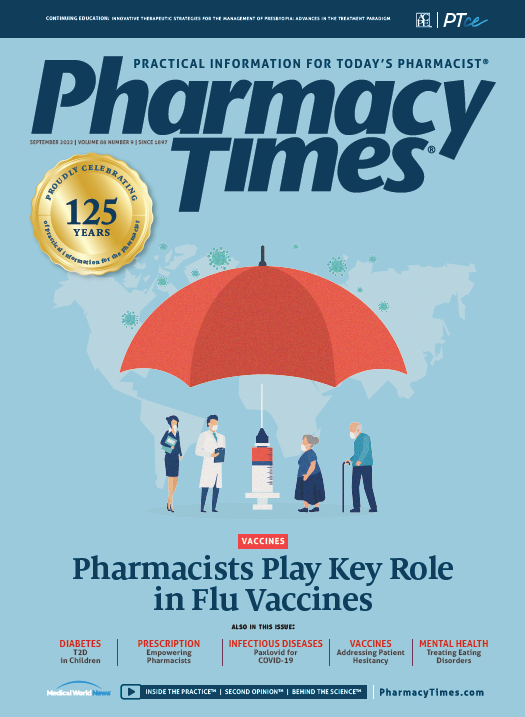Publication
Article
Pharmacy Times
Help Patients Prevent and Treat Dry Eye
Author(s):
Pharmacists should ascertain whether self-treatment is appropriate and suggest medical care if it isn’t.
Dry eye disease (DED), also known as dry eye syndrome, dysfunctional tear syndrome, and keratoconjunctivitis sicca, is a chronic multifactorial disease of the ocular surface characterized by hyperosmolarity, inadequate production and/or instability of the tear film, and ocular surface damage and inflammation.1-3
Data from a recent National Health and Wellness Survey show that an estimated 16.4 million adults in the United States (6.8% of the population) have received diagnoses of DED to some degree.1,4 Considered the most common disorder affecting the anterior eye, DED can be mild, moderate, or severe1,5 and often correlates with ocular discomfort, fatigue, and visual disturbance that can significantly affect quality of life.2,6
Although the most common clinical symptom is a sandy, gritty sensation in the eye, DED can also cause blurry vision, discharge, excessive tearing, redness, inflammation, and photophobia.1-5
Research results have established DED is often associated with aging and women are twice as likely as men to develop it. DED commonly occurs during pregnancy, menopause, and postmenopause and with Bell palsy, corneal defects, diabetes, loss of lid tissue turgor, lupus, Parkinson disease, rheumatoid arthritis, rosacea, Sjogren syndrome, thyroid-related eye disorders, and vitamin A deficiency.1,4,5 DED is also an adverse effect of some pharmacological agents, including antidepressants, antihistamines, beta-blockers, decongestants, diuretics, and oral contraceptives.5 Some study results have indicated an increased risk of DED in those with sleep apnea who use continuous positive airway pressure therapy.7
Results of numerous cross-sectional studies have shown duration of digital screen use correlates with severe symptoms of DED in adults and long-term screen times are linked to greater risk of DED in school-aged children.8,9 Allergens, environmental factors, and laser eye surgery can also contribute to or exacerbate DED.1,5 As frontline health care professionals, pharmacists can be instrumental in identifying medical conditions and/or pharmacological agents that increase the risk of DED. They can counsel patients about nonprescription products that provide symptomatic relief of mild to moderate DED and encourage those with undiagnosed or severe DED to seek evaluation by an ophthalmologist.
Counseling
Without timely diagnosis and treatment, DED may damage ocular tissues, especially the corneal surface.1,5,9,10 The primary goals of therapy are to prevent or alleviate symptoms, maintain or reestablish tears, minimize dryness and related discomfort, and support overall eye health.5,9,10
First-line treatment often entails nonpharmacological measures to decrease the incidence of DED and treat any inflammation of the eye- lids or eye surface that contributes to DED.1,5,9 These measures include applying warm compresses to the eyes, avoiding smoky environments, discontinuing (if possible) medications that cause DED, getting enough sleep, limiting screen time, staying hydrated, using a humidifier, and wearing sunglasses outdoors.1,5,9,10
Artificial tears and nonmedicated gels and ointments are the main self-treatments.5 Mild DED cases may be treated with less viscous products, and severe ones with products that are more viscous.5 When no contraindications are present, some ophthalmologists may also recommend omega-3 fatty acid supplements.5
Tips For Patients Using OTC Products1,5,9,10
- Adhere to manufacturer directions and recommendations.
- Apply ocular ointments at bedtime to keep eyes moist while sleeping and prevent blurry, dry eyes upon waking.
- If you have questions, ask pharmacists and/or primary health care providers.
- Discuss frequency of use with primary health care provider. Artificial tears are typically used once or twice daily, in the morning and at bedtime.
- Note that artificial tears without preservatives are less likely than those with preservatives to cause allergic reactions and/or irritate ocular surface.
- Refrigerate artificial tears for additional relief.
- Before applying ocular gels, ointments, or drops, wash hands thoroughly with soap and water and remove contact lenses, if applicable.
Conclusion
Whenever possible, pharmacists should ascertain whether self-treatment is appropriate and, if it isn’t, suggest patients seek medical care. They should tell patients whose symptoms don’t improve or worsen with OTC products to ask an ophthalmologist for prescription medications like lifitegrast or cyclosporine ophthalmic emulsion. They should encourage patients with red or painful eyes, severe DED, or signs of ocular infection to see an ophthalmologist immediately. And they should recommend that patients visit www. allaboutvision.com.
About The Author
Yvette C. Terrie, BSPharm, RPh, is a consulting pharmacist and medical writer in Haymarket, Virginia.
Reference
1. Dry eye. National Institutes of Health. Updated April 8, 2022. Accessed August 1, 2022. https://www.nei.nih.gov/learn-about-eye-health/eye-conditions-and-diseases/dry-eye
2. Labetoulle M, Benitez del Castillo JM, Barabino S, et al. Artificial tears: biological role of their ingredients in the management of dry eye disease. Int J Mol Sci. 2022;23(5):2434. doi:10.3390/ ijms23052434
3. Bron AJ, de Paiva CS, Chauhan SK, et al. TFOS DEWS II pathophysiology report. Ocul Surf. 2017;15(3):438-510. doi:10.1016/j.jtos.2017.05.011
4. Farrand KF, Fridman M, Stillman IÖ, Schaumberg DA. Prevalence of diagnosed dry eye disease in the United States among adults aged 18 years and older. Am J Ophthalmol. 2017;182:90-98. doi:10.1016/j.ajo.2017.06.033
5. Fiscella RG, Jensen MK. Ophthalmic disorders. In: Krinsky DL, Berardi RR, Ferreri SP, et al, eds. Handbook of Nonprescription Drugs: An Interactive Approach to Self-Care. 20th ed. American Pharmacists Association; 2020:507-530.
6. Stapleton F, Alves M, Bunya VY, et al. TFOS DEWS II epidemiology report. Ocul Surf. 2017;15(3):334- 365. doi:10.1016/j.jtos.2017.05.003
7. Matossian C, Song X, Chopra I, Sainski-Nguyen A, Ogundele A. The prevalence and incidence
of dry eye disease among patients using continuous positive airway pressure or other nasal mask therapy devices to treat sleep apnea. Clin Ophthalmol. 2020;14:3371-3379. doi:10.2147/OPTH. S274949
8. Al-Mohtaseb Z, Schachter S, Shen Lee B, Garlich J, Trattler W. The relationship between dry eye disease and digital screen use. Clin Ophthalmol. 2021;15:3811-3820. 2021. doi:10.2147/OPTH.S321591
9. Muntz A, Turnbull PRK, Kim AD, et al. Extended screen time and dry eye in youth. Cont Lens Anterior Eye. 2021;101541. doi:10.1016/j.clae.2021.101541
10. Dry eye. American Optometric Association. Accessed August 1, 2022. https://www.aoa.org/healthy-eyes/eye-and-vision-conditions/dry-eye?sso=






